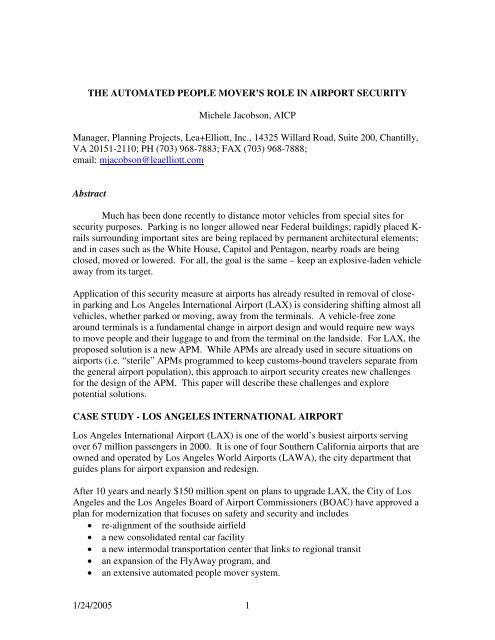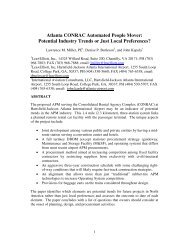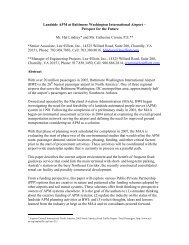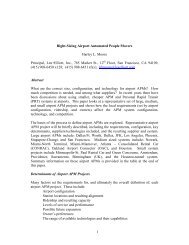the automated people mover's role in airport security - Lea+Elliott
the automated people mover's role in airport security - Lea+Elliott
the automated people mover's role in airport security - Lea+Elliott
You also want an ePaper? Increase the reach of your titles
YUMPU automatically turns print PDFs into web optimized ePapers that Google loves.
THE AUTOMATED PEOPLE MOVER’S ROLE IN AIRPORT SECURITY<br />
Michele Jacobson, AICP<br />
Manager, Plann<strong>in</strong>g Projects, <strong>Lea+Elliott</strong>, Inc., 14325 Willard Road, Suite 200, Chantilly,<br />
VA 20151-2110; PH (703) 968-7883; FAX (703) 968-7888;<br />
email: mjacobson@leaelliott.com<br />
Abstract<br />
Much has been done recently to distance motor vehicles from special sites for<br />
<strong>security</strong> purposes. Park<strong>in</strong>g is no longer allowed near Federal build<strong>in</strong>gs; rapidly placed K-<br />
rails surround<strong>in</strong>g important sites are be<strong>in</strong>g replaced by permanent architectural elements;<br />
and <strong>in</strong> cases such as <strong>the</strong> White House, Capitol and Pentagon, nearby roads are be<strong>in</strong>g<br />
closed, moved or lowered. For all, <strong>the</strong> goal is <strong>the</strong> same – keep an explosive-laden vehicle<br />
away from its target.<br />
Application of this <strong>security</strong> measure at <strong>airport</strong>s has already resulted <strong>in</strong> removal of close<strong>in</strong><br />
park<strong>in</strong>g and Los Angeles International Airport (LAX) is consider<strong>in</strong>g shift<strong>in</strong>g almost all<br />
vehicles, whe<strong>the</strong>r parked or mov<strong>in</strong>g, away from <strong>the</strong> term<strong>in</strong>als. A vehicle-free zone<br />
around term<strong>in</strong>als is a fundamental change <strong>in</strong> <strong>airport</strong> design and would require new ways<br />
to move <strong>people</strong> and <strong>the</strong>ir luggage to and from <strong>the</strong> term<strong>in</strong>al on <strong>the</strong> landside. For LAX, <strong>the</strong><br />
proposed solution is a new APM. While APMs are already used <strong>in</strong> secure situations on<br />
<strong>airport</strong>s (i.e. “sterile” APMs programmed to keep customs-bound travelers separate from<br />
<strong>the</strong> general <strong>airport</strong> population), this approach to <strong>airport</strong> <strong>security</strong> creates new challenges<br />
for <strong>the</strong> design of <strong>the</strong> APM. This paper will describe <strong>the</strong>se challenges and explore<br />
potential solutions.<br />
CASE STUDY - LOS ANGELES INTERNATIONAL AIRPORT<br />
Los Angeles International Airport (LAX) is one of <strong>the</strong> world’s busiest <strong>airport</strong>s serv<strong>in</strong>g<br />
over 67 million passengers <strong>in</strong> 2000. It is one of four Sou<strong>the</strong>rn California <strong>airport</strong>s that are<br />
owned and operated by Los Angeles World Airports (LAWA), <strong>the</strong> city department that<br />
guides plans for <strong>airport</strong> expansion and redesign.<br />
After 10 years and nearly $150 million spent on plans to upgrade LAX, <strong>the</strong> City of Los<br />
Angeles and <strong>the</strong> Los Angeles Board of Airport Commissioners (BOAC) have approved a<br />
plan for modernization that focuses on safety and <strong>security</strong> and <strong>in</strong>cludes<br />
• re-alignment of <strong>the</strong> southside airfield<br />
• a new consolidated rental car facility<br />
• a new <strong>in</strong>termodal transportation center that l<strong>in</strong>ks to regional transit<br />
• an expansion of <strong>the</strong> FlyAway program, and<br />
• an extensive <strong>automated</strong> <strong>people</strong> mover system.<br />
1/24/2005 1
Figure 1.<br />
Los Angeles International Airport<br />
A second phase of development has been temporarily deferred to allow time for<br />
additional studies <strong>in</strong>volv<strong>in</strong>g vehicular traffic impacts, aviation activity and <strong>security</strong> issues<br />
before be<strong>in</strong>g implemented. Elements of <strong>the</strong> second phase <strong>in</strong>clude<br />
• an off-site check-<strong>in</strong> counter<br />
• demolition of Term<strong>in</strong>als 1, 2 and 3, and<br />
• a new term<strong>in</strong>al complex where <strong>the</strong> park<strong>in</strong>g garages are now.<br />
The approved plan ma<strong>in</strong>ta<strong>in</strong>s a gate capacity to accommodate growth to 78 million<br />
annual passengers. Although <strong>the</strong> tim<strong>in</strong>g of <strong>the</strong> second phase of development is unknown,<br />
APM plann<strong>in</strong>g assumes an eventual full build-out of <strong>the</strong> plan. This paper will explore<br />
APM design and operational issues related to full build-out. F<strong>in</strong>al Federal approval is<br />
expected early <strong>in</strong> 2005 and construction projects at LAX would start soon after.<br />
The current <strong>airport</strong> landside layout is shown <strong>in</strong> Figure 2.<br />
1/24/2005 2
Figure 2.<br />
Exist<strong>in</strong>g Landside Access Conditions<br />
Alternative “D”<br />
Through analysis of several alternatives <strong>in</strong> <strong>the</strong> Environmental Impact Statement/<br />
Environmental Impact Report (EIS/EIR), it was determ<strong>in</strong>ed that Alternative D, <strong>the</strong><br />
Enhanced Safety and Security Alternative, is <strong>the</strong> environmentally preferable option for<br />
achiev<strong>in</strong>g <strong>the</strong> project’s objectives. The project has been broken <strong>in</strong>to two development<br />
phases, as described above, but <strong>the</strong> project’s major objectives have rema<strong>in</strong>ed <strong>the</strong> same –<br />
safety and <strong>security</strong>.<br />
As Los Angeles Mayor James K. Hahn stated upon <strong>the</strong> City Council’s recent decision to<br />
move forward with <strong>the</strong> plan for modernization, “Today <strong>the</strong> City of Los Angeles<br />
demonstrated a shared commitment to creat<strong>in</strong>g a safer, more secure <strong>airport</strong>. My primary<br />
<strong>in</strong>terest <strong>in</strong> improv<strong>in</strong>g <strong>the</strong> <strong>airport</strong> is to <strong>in</strong>crease <strong>the</strong> <strong>security</strong> of LAX’s employees, travelers<br />
and <strong>in</strong>frastructure. This plan will enhance <strong>the</strong> safety of <strong>the</strong> millions of passengers who<br />
move through <strong>the</strong> <strong>airport</strong> every year.”<br />
1/24/2005 3
Central to <strong>the</strong> concept of Alternative D is a new design approach to secur<strong>in</strong>g <strong>airport</strong>s.<br />
The approach is manifested <strong>in</strong> numerous areas throughout <strong>the</strong> <strong>airport</strong>, but this paper will<br />
focus on <strong>the</strong> measures that relate to landside access and particularly to <strong>the</strong> planned APM<br />
system.<br />
Landside Plans<br />
One eventual goal at LAX is to limit access by private vehicles to <strong>the</strong> ma<strong>in</strong> <strong>airport</strong><br />
<strong>in</strong>frastructure. Airport access will be provided through four remote landside po<strong>in</strong>ts,<br />
provid<strong>in</strong>g redundancy and solv<strong>in</strong>g many of <strong>the</strong> traffic congestion problems associated<br />
with <strong>the</strong> current <strong>airport</strong> access system. The four remote landside po<strong>in</strong>ts will be connected<br />
via an extensive APM system.<br />
The four facilities compris<strong>in</strong>g <strong>the</strong> landside system are <strong>the</strong> Central Term<strong>in</strong>al (CTA), <strong>the</strong><br />
Ground Transportation Center (GTC), an Intermodal Transportation Center (ITC) and a<br />
Consolidated Rental Car Facility (RAC). As described <strong>in</strong> <strong>the</strong> LAX Master Plan F<strong>in</strong>al<br />
EIS/EIR:<br />
“A new GTC would be <strong>the</strong> primary <strong>airport</strong> access center for private and<br />
most commercial vehicles. A <strong>people</strong> mover would connect <strong>the</strong> GTC with<br />
<strong>the</strong> CTA. The GTC would be <strong>the</strong> primary access po<strong>in</strong>t for all passenger<br />
drop-off and pick-up and for private vehicle park<strong>in</strong>g.<br />
An ITC would serve as <strong>the</strong> connection po<strong>in</strong>t between <strong>the</strong> <strong>airport</strong>, <strong>the</strong><br />
Green L<strong>in</strong>e and regional bus service. The exist<strong>in</strong>g MTA Green L<strong>in</strong>e<br />
station located at Aviation Boulevard would be l<strong>in</strong>ked to <strong>the</strong> proposed ITC<br />
by a covered walkway. In addition, <strong>the</strong> ITC would provide park<strong>in</strong>g<br />
facilities for <strong>the</strong> public and large buses. The MTA buses would use <strong>the</strong><br />
MTA Green L<strong>in</strong>e station. The APM would connect <strong>the</strong> ITC to <strong>the</strong> CTA,<br />
with a stop at <strong>the</strong> RAC facility.<br />
The access po<strong>in</strong>t to <strong>the</strong> exist<strong>in</strong>g CTA roadway would be controlled to<br />
enhance access <strong>in</strong> <strong>the</strong> areas immediately surround<strong>in</strong>g <strong>the</strong> <strong>airport</strong>’s critical<br />
<strong>in</strong>frastructure. Primary public <strong>airport</strong> access would be provided via <strong>the</strong><br />
APM from <strong>the</strong> GTC and ITC. FlyAway buses and o<strong>the</strong>r vehicles that are<br />
currently cleared to drive on <strong>the</strong> secure airside of <strong>the</strong> <strong>airport</strong>, like <strong>airport</strong><br />
operations, police and fire protection would use <strong>the</strong> exist<strong>in</strong>g CTA roadway<br />
system to access <strong>the</strong> new term<strong>in</strong>als. Delivery vehicles would be primarily<br />
directed to a consolidated warehouse with<strong>in</strong> <strong>the</strong> <strong>airport</strong> for <strong>security</strong><br />
screen<strong>in</strong>g and <strong>in</strong>ternal distribution control. Delivery vehicles access<strong>in</strong>g<br />
<strong>the</strong> CTA would proceed to designated delivery locations at <strong>the</strong> new<br />
term<strong>in</strong>als once <strong>the</strong>y have passed <strong>the</strong> screen<strong>in</strong>g process.<br />
Public park<strong>in</strong>g would be provided <strong>in</strong> <strong>the</strong> ITC, <strong>the</strong> GTC, and <strong>in</strong> an<br />
expanded Lot B. The GTC would consist of three garages and provide<br />
1/24/2005 4
approximately 7,515 stalls, made up of both short-term and long-term<br />
park<strong>in</strong>g. The ITC facilities would provide approximately 9,125 short-term<br />
park<strong>in</strong>g stalls. The surface lot north of 111 th Street would be <strong>in</strong>corporated<br />
<strong>in</strong>to Lot B and would provide 5,470 long-term park<strong>in</strong>g stalls. A shuttle<br />
bus would transport <strong>people</strong> between this lot and <strong>the</strong> ITC for <strong>people</strong> mover<br />
access to <strong>the</strong> CTA. In addition, <strong>the</strong>re would be approximately 12,890<br />
park<strong>in</strong>g stalls located off-<strong>airport</strong> and operated by private park<strong>in</strong>g<br />
providers, provid<strong>in</strong>g a total of 35,000 public park<strong>in</strong>g stalls.<br />
A new 12,400-stall employee park<strong>in</strong>g garage would be constructed. Some<br />
employees will use an exist<strong>in</strong>g 1,200-stall garage on <strong>the</strong> sou<strong>the</strong>ast corner<br />
of Avion Drive and Century Boulevard. They will be shuttled to a <strong>people</strong><br />
mover station for access to <strong>the</strong> CTA, GTC or ITC.<br />
Rental car facilities would be consolidated <strong>in</strong> a campus. A three-level,<br />
150,000-square-foot customer service build<strong>in</strong>g would be adjacent to <strong>the</strong><br />
APM, a passenger station, and a four-level, 9,000-space ready/return<br />
garage. A baggage tunnel is be<strong>in</strong>g considered for transport<strong>in</strong>g oversized<br />
items, but at this po<strong>in</strong>t it is assumed that most baggage will be transported<br />
on <strong>the</strong> APM.<br />
Figure 3.<br />
Alternative D layout<br />
1/24/2005 5
APM Design Issues<br />
Volumes<br />
The APM system will be designed as a “must-ride” system, mean<strong>in</strong>g that it will be <strong>the</strong><br />
only way for almost all of <strong>the</strong> employees, passengers and luggage to get to or leave <strong>the</strong><br />
<strong>airport</strong> term<strong>in</strong>als. The only <strong>people</strong> who will not use <strong>the</strong> system are some of <strong>the</strong><br />
employees and those passengers arriv<strong>in</strong>g on <strong>the</strong> FlyAway buses. This is a significant<br />
departure from exist<strong>in</strong>g <strong>airport</strong> landside APM systems that carry only a portion of <strong>the</strong><br />
landside population.<br />
Virtually all o<strong>the</strong>r <strong>airport</strong> landside APM systems <strong>in</strong> <strong>the</strong> world provide one service option<br />
among many or serve a limited number of passengers. For example, a passenger travel<strong>in</strong>g<br />
from Manhattan to John F. Kennedy Airport can take <strong>the</strong> subway to Jamaica Station and<br />
catch <strong>the</strong> APM <strong>in</strong>to <strong>the</strong> <strong>airport</strong>, but <strong>the</strong>y could also travel <strong>the</strong> entire route by cab, bus, or<br />
private auto. And <strong>in</strong> <strong>the</strong> case of <strong>the</strong> landside portion of <strong>the</strong> APM at San Francisco<br />
Airport, <strong>the</strong> service is limited to <strong>people</strong> travel<strong>in</strong>g between <strong>the</strong> term<strong>in</strong>al and <strong>the</strong> rental car<br />
facility and some of <strong>the</strong> park<strong>in</strong>g – a relatively small segment of those travel<strong>in</strong>g <strong>in</strong> <strong>the</strong><br />
landside area of <strong>the</strong> <strong>airport</strong>.<br />
Based upon LAX’s planned ultimate <strong>airport</strong> build-out of 78 million annual passengers,<br />
<strong>the</strong> APM system is been designed to provide a capacity of 14,000 pphpd. This assumes a<br />
vehicle density factor of less than 40 to around 50 passengers per vehicle, depend<strong>in</strong>g<br />
upon <strong>the</strong> luggage assumptions of each route. This is a much lower density than most<br />
o<strong>the</strong>r <strong>airport</strong> situations. The lower number is due <strong>in</strong> part to <strong>the</strong> must-ride nature of <strong>the</strong><br />
system. If most passengers must ride on <strong>the</strong> APM, <strong>the</strong>re will be a higher than usual<br />
number of <strong>people</strong> us<strong>in</strong>g <strong>the</strong> system with large amounts of luggage. People carry<strong>in</strong>g large<br />
amounts of luggage often choose to come by auto (ei<strong>the</strong>r taxi or private) to be dropped<br />
off at <strong>the</strong> CTA’s curbside, ra<strong>the</strong>r than ei<strong>the</strong>r park<strong>in</strong>g <strong>the</strong>ir cars and carry<strong>in</strong>g <strong>the</strong>ir bags<br />
from <strong>the</strong> garage or tak<strong>in</strong>g public transit. For <strong>the</strong> same reasons, <strong>the</strong>re will be a higher<br />
proportion of passengers us<strong>in</strong>g luggage carts. Both factors lead to lower density factors.<br />
Siz<strong>in</strong>g <strong>the</strong> system also needs to address surg<strong>in</strong>g of passengers and <strong>the</strong> potential for very<br />
large aircraft and <strong>the</strong>ir accompany<strong>in</strong>g high passenger numbers.<br />
Security Opportunities<br />
One of <strong>the</strong> approaches to <strong>airport</strong> <strong>security</strong> that is embedded throughout Alternative D is to<br />
<strong>in</strong>crease <strong>the</strong> opportunities for additional levels of screen<strong>in</strong>g. These will <strong>in</strong>clude, but not<br />
be limited to, improved and consolidated employee <strong>security</strong> screen<strong>in</strong>g facilities, bombsniff<strong>in</strong>g<br />
dogs, passenger profil<strong>in</strong>g, and <strong>security</strong> screen<strong>in</strong>g of all checked baggage. Phase<br />
two of Alternative D will <strong>in</strong>clude replac<strong>in</strong>g exist<strong>in</strong>g curbside, drop-off/pick-up, and<br />
park<strong>in</strong>g <strong>in</strong> <strong>the</strong> Central Term<strong>in</strong>al area to <strong>the</strong> four remote landside po<strong>in</strong>ts. The f<strong>in</strong>al layout<br />
provides <strong>in</strong>creased <strong>security</strong> by dispers<strong>in</strong>g passenger process<strong>in</strong>g and by separat<strong>in</strong>g<br />
passenger process<strong>in</strong>g from vehicles.<br />
1/24/2005 6
By provid<strong>in</strong>g <strong>the</strong> l<strong>in</strong>k between <strong>the</strong> remote landside po<strong>in</strong>ts and <strong>the</strong> Central Term<strong>in</strong>al, <strong>the</strong><br />
APM enables <strong>the</strong> disbursement of check-<strong>in</strong> po<strong>in</strong>ts as well as <strong>the</strong> separation between <strong>the</strong><br />
passenger process<strong>in</strong>g and park<strong>in</strong>g. The APM also provides more opportunity for crowd<br />
control. In typical <strong>airport</strong> landside arrangements, <strong>the</strong> type (ticketed passengers,<br />
employees, meeters and greeters, etc.) and number of <strong>people</strong> enter<strong>in</strong>g and exit<strong>in</strong>g <strong>the</strong><br />
term<strong>in</strong>al is varied and difficult to control. In an attempt to ga<strong>in</strong> some control over who<br />
and what approaches <strong>the</strong> term<strong>in</strong>al area, some <strong>airport</strong>s have <strong>in</strong>stituted vehicle checkpo<strong>in</strong>ts<br />
on roads approach<strong>in</strong>g <strong>the</strong> term<strong>in</strong>al. In some o<strong>the</strong>r <strong>in</strong>stances, <strong>the</strong> general public is<br />
relegated via signage to an outside curbside lane. Several aspects of <strong>the</strong> APM will offer<br />
greater control to <strong>the</strong> <strong>airport</strong>.<br />
The capacity limitations of <strong>the</strong> APM vehicles provide control of <strong>the</strong> flow of passengers<br />
from <strong>the</strong> remote landside po<strong>in</strong>ts. Each tra<strong>in</strong> will deliver a maximum number of <strong>people</strong> to<br />
<strong>the</strong> term<strong>in</strong>al at set and known <strong>in</strong>tervals. Airport term<strong>in</strong>al design and <strong>security</strong> procedures<br />
can respond accord<strong>in</strong>gly. And if someth<strong>in</strong>g goes wrong <strong>the</strong> flow of <strong>people</strong> can be<br />
stopped very quickly. Additionally, if desired, <strong>the</strong> APM can be used to limit access to<br />
certa<strong>in</strong> passenger groups, such as employees. As is done <strong>in</strong> certa<strong>in</strong> <strong>airport</strong>s today, <strong>the</strong><br />
APM can stop at only select stations that can be secured through <strong>the</strong> use of facility<br />
design. And f<strong>in</strong>ally, an APM offers <strong>the</strong> ability to control <strong>the</strong> vehicle’s operation<br />
<strong>in</strong>clud<strong>in</strong>g its ultimate dest<strong>in</strong>ation and when <strong>the</strong> doors open to allow egress. This could<br />
provide <strong>security</strong> personnel with a valuable tool to augment passenger profil<strong>in</strong>g.<br />
Reliability<br />
While any type of landside transportation system can experience problems lead<strong>in</strong>g to<br />
delays, <strong>the</strong> must-ride nature of <strong>the</strong> LAX APM system translates <strong>in</strong>to <strong>the</strong> need for even<br />
higher standards of reliability. Traffic jams on major travel days can render an <strong>airport</strong>’s<br />
landside road system nearly useless but <strong>in</strong> many busy <strong>airport</strong>s, passengers can avoid <strong>the</strong><br />
traffic by us<strong>in</strong>g rail, as <strong>in</strong> <strong>the</strong> case of <strong>the</strong> Metro to National Airport <strong>in</strong> Wash<strong>in</strong>gton, D.C.<br />
Additionally, major travel days and peak commute periods are predictable and <strong>people</strong> can<br />
plan <strong>the</strong>ir trip around <strong>the</strong> congestion by allow<strong>in</strong>g more time to get to <strong>the</strong> <strong>airport</strong>. The<br />
roadway system can fail because of <strong>the</strong> overabundance of users. It is extremely rare that<br />
<strong>the</strong> roadway system itself fails, such as when a s<strong>in</strong>khole develops or an earthquake<br />
destroys portions of <strong>the</strong> roads. It is easier to imag<strong>in</strong>e an APM malfunction<strong>in</strong>g and<br />
possibly stopp<strong>in</strong>g an entire system. A number of design and operational options are<br />
be<strong>in</strong>g considered to address this challenge.<br />
Ease of Use<br />
There is no need to make fly<strong>in</strong>g more complicated or stressful. As for all <strong>airport</strong> APM<br />
systems, it needs to be remembered that <strong>the</strong> number of <strong>people</strong> familiar with us<strong>in</strong>g fixed<br />
guideway systems is a small percentage of <strong>the</strong> general population and often not<br />
co<strong>in</strong>cidental with those us<strong>in</strong>g an <strong>airport</strong>. The ultimate configuration of this system will<br />
need to address ease of use by <strong>the</strong> traveler.<br />
1/24/2005 7
Good signage is an obvious tool, but <strong>the</strong> system layout will have a more significant<br />
impact on how easy <strong>the</strong> system is to use. Trips need to be as direct as possible and<br />
transfers between tra<strong>in</strong>s should be avoided. Station crowd<strong>in</strong>g needs to be avoided and<br />
passenger surges accommodated. Use of platforms for multiple routes can add to a user’s<br />
confusion and so dedicated platforms should be used whenever possible. One of <strong>the</strong><br />
challenges <strong>in</strong> <strong>the</strong> case of LAX is to provide this level of service while also offer<strong>in</strong>g<br />
travelers <strong>the</strong> maximum number of options and fitt<strong>in</strong>g <strong>the</strong> system <strong>in</strong>to <strong>the</strong> <strong>airport</strong> layout.<br />
Conclusion<br />
Creat<strong>in</strong>g a vehicle-free zone around an <strong>airport</strong> term<strong>in</strong>al is a bold design approach that is<br />
reliant upon a new way of collect<strong>in</strong>g and mov<strong>in</strong>g <strong>people</strong> through <strong>the</strong> landside area. An<br />
APM offers an efficient way to take large numbers of <strong>people</strong> <strong>the</strong> f<strong>in</strong>al leg from remote<br />
collection po<strong>in</strong>ts <strong>in</strong>to <strong>the</strong> core passenger process<strong>in</strong>g area. The success of such an<br />
approach, however, demands a reth<strong>in</strong>k<strong>in</strong>g of many established standards and past<br />
assumptions used for <strong>airport</strong> APMs. Hard decisions need to be made on siz<strong>in</strong>g, <strong>security</strong>,<br />
reliability, system configuration, and ease of use. Critical to tailor<strong>in</strong>g <strong>the</strong> solution to <strong>the</strong><br />
challenge will be careful attention to details and constant reassessment of each decision<br />
aga<strong>in</strong>st project goals.<br />
1/24/2005 8








